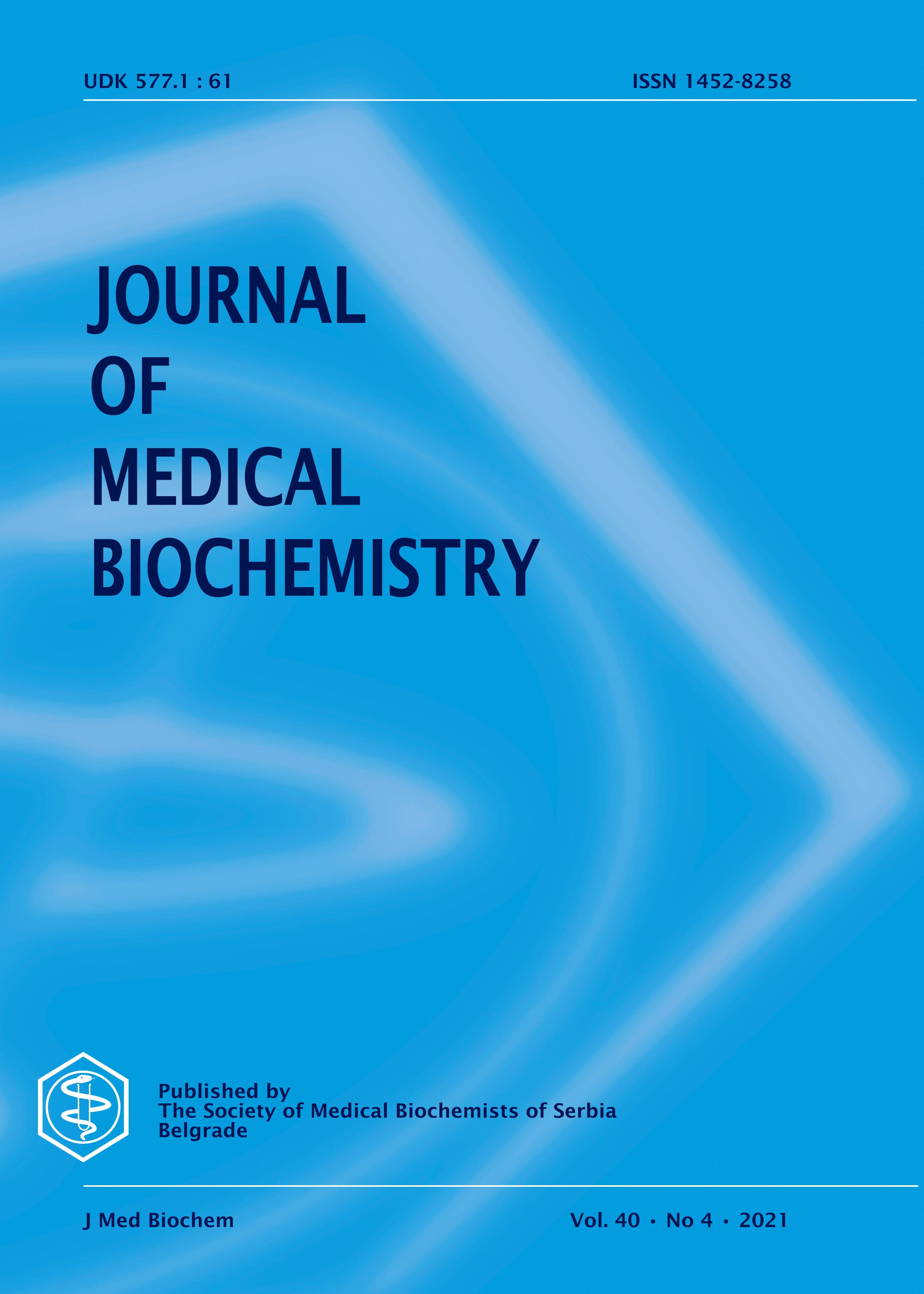Comparative study of Chemical Pathology sample collection tubes at the largest hospital in South Africa
Comparison between BarricorTM and serum separator tubes
Sažetak
Background: BarricorTM lithium heparin plasma tubes are new blood tubes that have been introduced to overcome the effects of gel in serum separator tubes (SST) and the shortcomings of standard lithium heparin plasma. We aimed to evaluate BarricorTM tubes as an alternative to serum separator tubes and compare the stability between the tubes.
Methods: Forty-four paired samples were collected using both BarricorTM and SST. We compared five analytes at baseline (<6h) and after every 24h using the Passing-Bablok and Bland-Altman plots. Aspartate aminotransferase (AST), potassium (K), phosphate (PO4), lactate dehydrogenase (LDH), and creatinine were analysed in both tubes. We calculated the percentage difference for each analyte between the baseline and time intervals to assess analyte stability. The percentage difference was compared to the desirable specification for bias and reference change value (RCV).
Results: All analytes were comparable at baseline. Statistical differences (p<0.001) became evident after 24h. PO4, K, and creatinine had a mean difference that exceeded the desirable specification for bias (-9.59%, -9.35%, and -4.59%, respectively). Potassium was stable up to 24h in both tubes. LDH showed better stability in SST (144h vs. 96h). PO4 concentrations were more stable in both tubes with the SST (96h vs. 72h). Creatinine and AST had the longest stability in both tubes compared to other analytes (144h).
Conclusions: Data demonstrated variability and similarities in analyte concentrations and stability, respectively in both tubes
Reference
1. Bowen RAR, Remaley AT. Interferences from blood collection tube components on clinical chemistry assay. Biochem Med. 2014;24(1):31-44.
2. Cadamuro J, Wiedemann H, Felder TK, Mrazek C, Kipman U, Hannes O, Haschke-Becher E. What’s floating on my plasma? Biochem Med. 2017;27(2):430-3.
3. Babic N, Zibrat S, Gordon IO, Lee CC, Yeo KT. Effect of blood collection tubes on the incidence of artifactual hyperkalaemia on patient samples from an outreach clinic. Clin Chim Acta. 2012;413:1454-8.
4. Ji SQ, Evenson MA. Effects of contaminants in blood collection devices on the measurement of therapeutic drugs. Clin Chem 1983;29:456-61.
5. Arslan FD, Karakoyun I, Basok BI, Aksit MZ, Baysoy A, Ozturk YK, Guclu YA, Duman C. The local clinical validation of a new lithium heparin tube with a barrier: BD vacutainer® Barricor LH plasma tube. Biochem Med. 2017;27(3).
6. www.barricor.bd.com/us/how-bd-barricor-tube-works.xml. (accessed 12th December 2019)
7. Fournier JE, Northrup V, Clark C, Fraser J, Howlett M, Atkinson P, Shea JL. Evaluation of BD Vacutainer® BarricorTM blood collection tubes for routine chemistry testing on Roche Cobas® 8000 platform. Clin Biochem. 2018;58:94-9.
8. Füzéry AK, Raizman JE, Goudreau BL, Moses K, Niemann K, Park J, Cembrowski GS. The BD Barricor blood collection tube is an acceptable and robust alternative to the PST for use with the Beckman AccuTnI+ 3 assay. Clin Biochem. 2017;50: 851-7.
9. Dupuy AM, Badiou S, Daubin D, Bargnoux AS, Magnan C, Klouche K, Cristol JP. Comparison of BarricorTM vs. lithium heparin tubes for selected routine biochemical analytes and evaluation of post centrifugation stability. Biochem Med. 2018;28(2):020902.
10. Dimeski G, Johnston J. Is the BD barricor tube the new standard for lithium heparin plasma? Developments in Clinical & Medical Pathology. 2018;1(3).
11. European Federation of Clinical Chemistry and Laboratory Medicine (EFLM) Biological Varation Database Available at: https://biologicalvariation.eu/. (accessed 12th December 2019).
12. Fraser CG. Reference change values. Clin Chem Lab Med. 2011;50(5):807-12.
13. Lum G, Gambino SR. A comparison of serum versus heparinized plasma for routine chemistry tests. Am J Clin Pathol. 1974;61: 108-13.
14. Ladenson JH, Tsai LM, Michael JM, Kessle G, Joist JH. Serum versus heparinized plasma for eighteen common chemistry tests: is serum the appropriate specimen? Am J Clin Pathol. 1974;62:545-52.
15. Balbás LAB, Amaro MS, Rioja RG, Martín MJA, Soto AB. Stability of plasma electrolytes in Barricor and PST II tubes under different storage conditions. Biochem Med. 2017;27(1):225-30.
16. Doumas BT, Hause LL, Simuncak DM, Breitenfeld D. Differences between values for plasma and serum in tests performed in the Ektachem 700 XR Analyzer, and evaluation of "plasma separator tubes (PST)". Clin Chem. 1989;35:151-3.
17. Cadamuro JC, Mrazek C, Leichtle AB, Kipman U, Felder TK, Wiedemann H, Oberkofler H, Fieldler GM, Hasche-Becker E. Influence of centrifugation conditions on the results of 77 routine clinical chemistry analytes using standard vacuum blood collection tubes and the new BD-Barricor tubes. Biochem Med. 2018;28(1):010704.
18. Raizman JE, Goudreau BL, Füzéry AK, Cembrowski GS. Barricor blood collection tubes are equivalent to PST for a variety of chemistry and immunoassy analytes except for lactate dehydrogenase. Clinica Chimica Acta. 2019;496.
19. Miles RR, Roberts RF, Putnam AR, WL. R. Comparison of Serum and Heparainized Plasma Samples for Measurement of Chemistry Analytes. Clin Chem. 2004;50(9):1704-5.
Sva prava zadržana (c) 2021 Siyabonga Khoza

Ovaj rad je pod Creative Commons Autorstvo 4.0 međunarodnom licencom.
The published articles will be distributed under the Creative Commons Attribution 4.0 International License (CC BY). It is allowed to copy and redistribute the material in any medium or format, and remix, transform, and build upon it for any purpose, even commercially, as long as appropriate credit is given to the original author(s), a link to the license is provided and it is indicated if changes were made. Users are required to provide full bibliographic description of the original publication (authors, article title, journal title, volume, issue, pages), as well as its DOI code. In electronic publishing, users are also required to link the content with both the original article published in Journal of Medical Biochemistry and the licence used.
Authors are able to enter into separate, additional contractual arrangements for the non-exclusive distribution of the journal's published version of the work (e.g., post it to an institutional repository or publish it in a book), with an acknowledgement of its initial publication in this journal.

